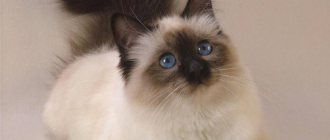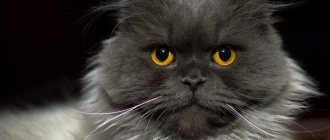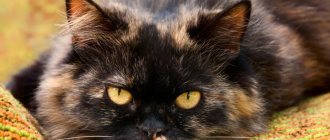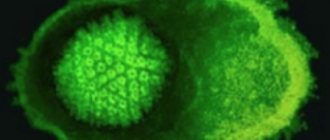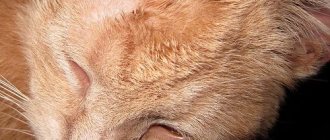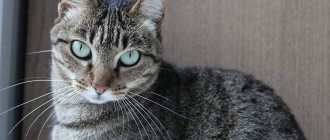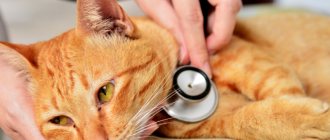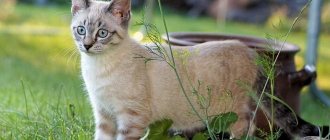Mastopathy in cats is diagnosed when there is excessive division of modified cells in the tissues of the mammary glands. The disease has a significant impact on the well-being of your pet and increases the risk of developing cancer. Early diagnosis of a mild form of mastopathy allows you to speed up the recovery process for your pet. Considering that the cat cannot complain of disturbing symptoms, you need to regularly examine the condition of its mammary glands yourself or at the veterinary clinic.
Causes of the disease
Clinical studies have established a close connection between mastopathy and the level of sex hormones in the cat’s body. An increase in milk reservoirs connected by a lymphatic duct outside of preparation for lambing (birth) is the first signal of distress. The reasons for this may be:
- imaginary tightness, resulting in an increase in hormonal levels;
- failure of the endocrine system;
- diseases of the reproductive and urinary systems;
- penetration of infectious pathogens into the mammary gland area through open wounds, abrasions, cuts, or through the lymph and blood flow from distant lesions;
- traumatic damage to milk tanks;
- decreased protective functions of the body;
- reproductive dysfunction – spontaneous or forced termination of pregnancy.
The risk of developing mastopathy in cats increases:
- early mating before full puberty;
- weaning kittens from feeding;
- stagnation of milk in the reservoirs of a nursing cat with increased lactation;
- prolonged stressful situations and hypothermia;
- overweight;
- use of high-dose contraceptive drugs.
Over many years of experience, veterinarians have come to the conclusion that the role of “sufferers” is most often assigned to Siamese cats and sphinxes.
Important! All individuals that were not sterilized before the first heat are automatically included in the risk group. You can learn all the pros and cons of sterilization from our article.
At-risk groups
Mastopathy most often affects mature and elderly cats or cats with hormonal problems. The risk groups for tumor diseases of the mammary glands include the following categories of animals:
- cats in a state of pregnancy or heat;
- animals after premature loss of cubs, stillbirth or death of offspring;
- males and females taking hormonal contraceptives for a long time;
- Siamese cats, in which the disease is registered 2 times more often than in other breeds.
Types of mastopathy in cats
Mastopathy in cats is classified by type, depending on the form of pathological changes and localization:
- diffuse - proliferation of connective tissue in the form of unformed small nodules, small strands and areas of compaction, coarsening of elastic collagen fibers;
- nodular – development of focal compactions and nodular proliferations;
- mixed - the formation of cystic and fibrous elements welded into conglomerates.
According to the characteristics of the course and severity of damage to milk bags, mastopathy is divided into several successive stages:
- serous – the initial phase during which serous matter accumulates in the mammary glands, which leads to swelling of the reservoirs; the process of transformation of healthy cells into pathologically altered ones starts;
- catarrhal - affects the veiny and integumentary epithelium, clogs the milk ducts;
- fibrous – interalveolar spaces and tissues adjacent to the milk ducts are affected;
- hemorrhagic - the walls of blood vessels become thinner, their permeability increases, which contributes to the outpouring of blood into the milk ducts and tissue seals;
- purulent - pus forms in the alveoli and ducts; ulcers appear outside the mammary gland, which gradually increase in volume and unite;
- abscess – cavities filled with pus form in the glands, behind, in the subcutaneous tissue; an abscess develops, which can lead to melting of the gland.
Important! Without timely and adequate treatment, mastopathy progresses, quickly passing through stage after stage.
Possible complications and their consequences
With early diagnosis and timely contact of the cat owner to the clinic, mastopathy can be successfully treated using a conservative or surgical method. Benign neoplasms are enclosed in a fibrous capsule, so there is a chance to remove the node without long-term consequences.
Most often, pet owners notice changes in the mammary glands in advanced stages. Possible complications of mastopathy are incurable cancerous tumors that grow into nearby tissues and metastasize to internal organs. Ulceration of the skin in pathology is fraught with the addition of a secondary infection and the development of purulent forms of mastitis and mastopathy, which can cause blood poisoning and death of the animal.
Symptoms
At the initial stage, mastopathy in cats occurs with mild symptoms. Behavior that is unusual for your pet helps you understand that a problem has arisen:
- decreased physical activity;
- apathetic state;
- long licking of nipples;
- lack of appetite;
- unjustified aggression.
As pathological changes progress, the clinical picture worsens. The following signs appear:
- dense nodules or formations are palpated in the reservoirs;
- there is redness and increased body temperature in the area where the diseased lobes are located;
- the lymph nodes adjacent to the source of inflammation enlarge;
- a secretion of a grayish-yellow hue or a curd mass interspersed with blood and pus is released from the nipples.
A nursing cat meows pitifully when feeding kittens or does not allow the babies near at all.
Important! In case of mastopathy, feeding kittens with mother's milk is interrupted. Diseased glands can become a source of infection for healthy offspring.
Diagnosis of the disease
Having discovered manifestations of mastopathy, it is not recommended to begin independent treatment without a preliminary examination. A person ignorant of veterinary medicine will not be able to correctly determine the type and stage of development of the disease. In addition, if a cat has not given birth, but has developed pathogenetic symptoms, this indicates serious disorders in the animal’s body.
The doctor will examine the animal, palpate the affected areas, and prescribe the necessary laboratory and hardware tests. To assess the general condition and nature of the pathology in mastopathy, the following are performed:
- blood sampling for general and biochemical analysis;
- collection of biomaterial for bacteriological, cytological and histological study;
- X-ray;
- Ultrasound.
Based on the diagnostic results, further actions are determined: how and how to treat mastopathy in a cat in each specific case.
Conclusion
To avoid the onset of the disease, you need to undergo a full examination of the animal on time, tests and visual examinations provided by veterinary clinics. By contacting our veterinary office, you will receive qualified assistance from specialists on any problem your pet may have.
You can also call a doctor at home, our veterinarians will arrive on time, at any time convenient for you. You should not engage in amateur treatment, this can lead to exacerbation or worsening of a disease that is at an early stage of development. Also, unjustified self-medication of an animal can worsen other parts of the body.
Breast cancer involves not only death, but also a deterioration in the life of the animal and its owner. It is a pity that not every person, being the owner of their pets, is fully aware of the responsibility of caring for a sick animal. Some people, unwilling to undergo treatment, throw their cat out into the streets or euthanize them, not wanting to endure the difficulties that arise. Let us be patient with our pets, who bring warmth and comfort to our homes.
Treatment
At home
At the initial stages (serous, catarrhal form of mastopathy), treatment can be carried out at home. If we are talking about a cat that has recently become a mother, first of all they express the milk and bandage the diseased lobes. To reduce lactation, limit fluid intake. The pet is transferred to dry food and given water only after eating. The limited regimen is followed until the treatment measures bring the expected results.
The following treatment regimen for mastopathy in cats is used as drug therapy.
Novocaine blockade. It is used for increased soreness of the milk lobes, leading to excessive anxiety of the animal. 5000 IU of Bicillin is diluted with Novocaine at the rate of 1 ml per kg of weight. Injected into the subcutaneous tissue at the border of the milk reservoir with the peritoneum. The procedure is carried out over 3 days.
Calcium gluconate – 10% solution. Warm to room temperature, inject 1 – 3 ml depending on weight. The injection is given once, if necessary repeated after 1 - 2 days.
Medicines are administered intramuscularly - into the tissues of the thigh or shoulder, or subcutaneously - into the withers or knee fold. You can read how to properly inject a cat yourself in our article.
Homeopathic medicines
- Katozal . Calculation – from 0.5 – 2.5 ml per 5 kg, 1 time per day, for a course of 3-5 days. Or Gamavit for 7 days.
- Mastomethrin . 1 – 2 injections per day until clinical manifestations disappear, or in a two-week cycle. It is possible to replace it with Travmatin with 5-day use.
- To reduce the painful reaction and stimulate regeneration processes, the damaged areas are covered with a thin layer of Trauma-gel 2 times a day.
The mechanisms of action of homeopathic remedies have not been studied, and there is no data on the likelihood of recovery.
Antibacterial therapy
If mastopathy in a cat is caused by the penetration of infectious pathogens, they resort to penicillin antibiotics and cephalosporins. The low weight of the sick animal allows the use of tablet forms of drugs.
- Cefadroxil – 1 time per day, at the same time, 20 mg/kg for a week.
- Ampicillin – 3 times a day, 30 mg/kg for 5 – 7 days.
If the treatment regimen is followed, the animal has a 90% chance of recovery.
Surgical intervention in the clinic
Severe forms of mastopathy in cats, with irreversible pathological changes, require surgical treatment. The operation is contraindicated for patients who are elderly and have heart and kidney problems. There is a danger of using anesthesia.
During surgical procedures, the overgrown, modified tissues are removed (resection). Based on the number of lesions, one exocrine gland or the entire line is removed. If there are extensive affected areas, both lines of the mammary glands are removed. This operation is included in the list of complex surgical interventions, and therefore is divided into two stages with an interval of 14 days.
To stabilize the animal’s condition, veterinarians usually recommend spaying at the same time. The purpose of a hysterovariectomy is to reduce the amount of estrogen in a cat's body.
A radical approach frightens owners, but it is better to take extreme measures than to lose a beloved pet. And one more nuance: the cat must undergo early rehabilitation after surgery in a veterinary clinic. Qualified care and treatment will protect against the development of possible complications.
Folk remedies
The main treatment of mastopathy can be supplemented with folk recipes.
Cabbage leaf relieves swelling and local redness well. The vegetable is lightly beaten with a knife, applied to the sore lobe, and secured with a light bandage or mesh.
- Chamomile flowers, marigold flowers, oak bark, and sage have anti-inflammatory properties. Principle of use: 4 g of any plant material is placed in a thermos. Pour 150 ml of boiled water, leave for 2 - 3 hours, cool to 36ºC, filter. Soak a medical napkin or a piece of gauze folded in several rows with the liquid, cover the milk lobes, and fix it. The procedure is carried out twice a day.
While the new mother is undergoing treatment, 2 tablespoons of sage tincture 3 times a day will help reduce milk production.
- Dimexide solution is diluted with boiled cooled water in a 1:1 ratio. Moisten a napkin, apply it to the affected area, capturing healthy tissue, and leave for 30 - 40 minutes. The drug activates the action of antibiotics, which allows you to reduce their dosage.
- Homemade ointments can compete with pharmacological agents for topical use. To do this, mix medical Vaseline with lanolin and alcohol-based propolis tincture in a ratio of 5:5:1. The mixture is distributed on a napkin, applied to a milk bag, and left for 3-4 hours.
- 50 g of high-quality vegetable oil (olive, sunflower, flaxseed) are intensively heated in a water bath. While the oil has not cooled, add propolis and beeswax and stir until smooth. The method of application is similar to the previous one.
What is strictly forbidden to do in case of mastopathy is to warm up the tumors. Heat activates the already increased growth of hyperplastic cells.
Using folk remedies as the only method of treatment, the owner must understand that the likelihood of a complete recovery is negligible. Alternative methods eliminate the symptoms, but not the disease itself.
Surgery to remove the tumor
If the benign nature of the mastopathy is confirmed and the size of the tumor is less than 2 cm, an operation is performed to remove the tumor. If the detected node is larger than 2-3 cm, the prognosis is questionable or unfavorable. Removal of the tumor is carried out after a complete clinical examination of the animal with the study of laboratory blood tests. Contraindications to surgical treatment are the advanced age of the cat, the malignant nature of the mastopathy, pathologies of the heart, kidneys and lungs, and the presence of metastases in the internal organs.
Surgical treatment of the tumor is performed with excision of surrounding healthy tissue. To prevent relapses, it is recommended to remove the ovaries and uterus simultaneously with the tumor. With a favorable prognosis, after excision of the tumor, the animal recovers completely.
Prevention of mastopathy
In order not to endanger the pet, the owner needs to take care of its health in advance:
- provide a balanced diet and dosed drinking to increase immunity weakened by childbirth and form proper lactation;
- carefully inspect and feel the milk bags of a nursing cat; if it is very swollen or painful, express;
- Trim kittens' claws to reduce the risk of nipple injury;
- timely deworming, getting rid of fleas, antiseptic treatment of scratches and injuries;
- stop using medications containing hormones and hormone-like substances;
- exclude contact between your pet and infected animals;
- Use products made from natural materials as a lounger.
If mastopathy is suspected, veterinarians recommend unscheduled mating. If the owner is not committed to caring for the offspring, the best solution is to sterilize the cat before the first heat. We must not forget about regular preventive examinations with a veterinarian. A simple procedure will save the owner’s nerves and the health of the four-legged household.
